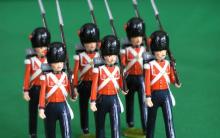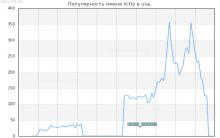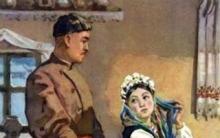“Poets of the Silver Age” - Mayakovsky entered the school of painting, sculpture and architecture. V. Ya. Bryusov (1873 – 1924). D. D. Burliuk. Nikolai Stepanovich Gumilev was born on April 15, 1886. Acmeists. O. E. Mandelstam. From 1900-1907 Mandelstam studied at the Tenishevsky Commercial School. O. E. Mandelstam (1891 – 1938). Acmeism. V. V. Mayakovsky.
“About front-line poets” - From the first days of the war, Kulchitsky was in the army. Simonov gained fame even before the war as a poet and playwright. Sergei Sergeevich Orlov (1921-1977). In 1944, Jalil was executed by Moabit executioners. Surkov’s poem “fire beats in a cramped stove” was written in 1941. Simonov’s poem “Wait for Me,” written during the war, became widely known.
“On Poetry” - Indian Summer has arrived - Days of farewell warmth. Your wonderful sunshine plays with our river. And at dawn the cherry glue hardens in the form of a clot. And all around were azure flowers, spreading spicy waves... A journey along a poetic path. The idea ended badly - An old rope broke... The face of a birch tree is under a wedding veil and transparent.
“Romanticism in literature” - Lesson - lecture. Lermontov Mikhail Yurievich 1814-1841. Romanticism in Russian literature, late 18th and early 19th centuries. The theme is “humiliated and insulted.” Philosophical tale. The romantic personality is a passionate personality. Historical novel; "Mtsyri". Passion. Walter Scott 1771-1832. The reasons for the emergence of romanticism.
“On Romanticism” - Larra. A.S. Pushkin. The Eternal Jew. Sacrifice yourself to save others. "The Legend of the Eternal Jew." Compositional features stories. "The Legend of Moses". M. Gorky. Which of the heroes is close to Old Woman Izergil: Danko or Larra? If you do nothing, nothing will happen to you. The basis of the romanticism style is the depiction of the inner world of man.
“Poets about nature” - Alexander Yesenin (father) and Tatyana Titova (mother). BLOK Alexander Alexandrovich (1880, St. Petersburg - 1921, Petrograd) - poet. A.A. Block. Russian writers of the 20th century native nature. Creative work. Landscape lyrics. Artistic and expressive means. S.A. Yesenin. The boy's grandmother knew many songs, fairy tales and ditties.
There are a total of 13 presentations in the topic
Which era in the history of art is closest to to modern man? The Middle Ages, the Renaissance - for a narrow circle of the elite, Baroque - is also a bit far away, classicism is perfect - but somehow too perfect, in life there is no such clear division into “three calms”... It’s better to keep quiet about modern times and modernity - this art only scares children (maybe it is true to the limit - but we are fed up with the “harsh truth of life” in reality). And if we choose an era, the art of which, on the one hand, is close and understandable, finds a living response in our soul, on the other hand, gives us refuge from everyday hardships, although it speaks of suffering - this is, perhaps, the 19th century, which has gone down in history like the era of romanticism. The art of this time gave rise to a special type of hero, called romantic.
The term " romantic hero" can immediately evoke the idea of a lover, echoing such stable combinations as " romantic relationship», « romantic story“- but this idea does not entirely correspond to reality. A romantic hero can be in love, but not necessarily (there are characters who correspond to this definition who were not in love - for example, Lermontov's Mtsyri has only a fleeting feeling for a graceful girl passing by, which does not become decisive in the fate of the hero) - and this is not the main thing in it... and what is the main thing?
To understand this, let us remember what romanticism was all about. It was generated by disappointment in the results of the Great French Revolution: the new world, which arose on the ruins of the old, was far from the “kingdom of reason” predicted by the enlighteners - instead, the “power of the money bag” was established in the world, a world where everything is for sale. Creative personality, retaining the ability to live human feeling, has no place in such a world, so a romantic hero is always a person, not accepted by society who came into conflict with him. Such, for example, is Johannes Kreisler, the hero of several works by E.T.A. Hoffmann (it is no coincidence that at the very beginning of the presentation of the “biography” of the hero, the author mentions that Kreisler was dismissed from the post of bandmaster, refusing to write an opera based on the poems of the court poet). “Johannes rushed here and there, as if on an eternally stormy sea, carried away by his visions and dreams, and, apparently, searched in vain for that pier where he could finally find peace and clarity.”
However, the romantic hero is not destined to “find calm and clarity” - he is a stranger everywhere, he is extra person... remember who this is said about? That's right, Evgeny Onegin also belongs to the type of romantic hero, or more precisely, to one of its variants - “disappointed”. Such a hero is also called “Byronic”, since one of his first examples is Byron’s Childe Harold. Other examples of a disappointed hero are “Melmoth the Wanderer” by Charles Maturin, partly Edmond Dantes (“The Count of Monte Cristo”), as well as “The Vampire” by J. Polidori (dear fans of “Twilight”, “Dracula” and other similar creations, please know , that all this subject, dear to you, goes back precisely to the romantic story by J. Polidori!). Such a character is always dissatisfied with his environment, because he rises above him, being more educated and intelligent. For his loneliness, he takes revenge on the world of philistines (narrow-minded ordinary people) with contempt for social institutions and conventions - sometimes bringing this contempt to the point of demonstrativeness (for example, Lord Rothven in the mentioned story by J. Polidori never gives alms to people driven to poverty by misfortunes, but never refuses in a request for financial assistance those who need money to satisfy vicious desires).
Another type of romantic hero is the rebel. He also opposes himself to the world, but enters into open conflict, he – in the words of M. Lermontov – “asks for a storm.” A wonderful example of such a hero is Lermontov’s Demon.
The tragedy of the romantic hero is not so much in being rejected by society (in fact, he even strives for this), but in the fact that his efforts always turn out to be directed “to nowhere.” Existing world does not satisfy him - but there is no other world, and nothing fundamentally new can be created by simply overthrowing secular conventions. Therefore, the romantic hero is doomed to either die in a collision with cruel world(Hoffman’s Nathaniel), or remain a “barren flower”, making no one happy or even destroying the lives of those around him (Onegin, Pechorin).
That is why, over time, disappointment in the romantic hero became inevitable - in fact, we see it in “Eugene Onegin” by A.S. Pushkin, where the poet openly ironizes about romanticism. Actually, not only Onegin can be considered a romantic hero here, but also Lensky, who also seeks an ideal and dies in a collision with the cruelty of a world that is very far from romantic ideals... but Lensky already resembles a parody of a romantic hero: his “ideal” is narrow-minded and frivolous a district young lady, outwardly reminiscent of a stereotypical image from novels, and the reader, in essence, is inclined to agree with the author, who prophesies a completely “philistine” future for the hero, if he remains alive... M. Lermontov is no less merciless towards his Zoraim, the hero of the poem “Angel of Death” :
“He looked for perfection in people,
And he himself was no better than them.”
Perhaps we find the finally degraded type of romantic hero in the opera by the English composer B. Britten (1913-1976) “Peter Grimes”: the main character here is also opposed to the world of ordinary people in which he lives, is also in eternal conflict with the inhabitants of his hometown and in the end In the end he dies - but he is no different from his nearby neighbors, his ultimate dream is to earn more money to open a shop... such is the harsh sentence passed on the romantic hero of the 20th century! No matter how you rebel against society, you will still remain a part of it, you will still carry its “cast” within you, but you will not run away from yourself. This is probably fair, but...
I once conducted a survey on a website for women and girls: “Which opera character would you marry?” Lensky took the lead by a huge margin - this is perhaps the romantic hero closest to us, so close that we are ready not to notice the author’s irony towards him. Apparently, to this day, the image of the romantic hero - eternally lonely and rejected, misunderstood by the “world of well-fed faces” and always striving for an unattainable ideal - retains its attractiveness.
Romanticism (1790-1830) is a trend in world culture that emerged as a result of the crisis of the Age of Enlightenment and its philosophical concept“Tabula rasa”, which means “ Blank sheet" According to this teaching, a person is born neutral, pure and empty, like White list paper. This means that if you educate him, you can raise an ideal member of society. But the flimsy logical structure collapsed when it came into contact with the realities of life: bloody Napoleonic Wars, French revolution 1789 and other social upheavals destroyed people's faith in the healing powers of the Enlightenment. During the war, education and culture did not play a role: bullets and sabers still spared no one. Powerful of the world this they studied diligently and had access to all famous works art, but this did not prevent them from sending their subjects to death, did not prevent them from cheating and cunning, did not prevent them from indulging in those sweet vices that from time immemorial have corrupted humanity, regardless of who and how they are educated. No one stopped the bloodshed, preachers, teachers and Robinson Crusoe with their blessed work and “God’s help” did not help anyone.
People are disappointed and tired of social instability. The next generation was “born old.” “Young people found use for their idle powers in desperation.”- as Alfred de Musset wrote, the author who wrote the brightest romantic novel"Confession of the son of the century." State young man He described his time as follows: “Denial of everything heavenly and everything earthly, if you like, hopelessness”. Society has become imbued with world grief, and the main postulates of romanticism are a consequence of this mood.
The word "romanticism" comes from the Spanish musical term "romance" (a piece of music).
Main features of romanticism
Romanticism is usually characterized by listing its main characteristics:
— Romantic dual world- This sharp contrast ideal and reality. Real world cruel and boring, and the ideal is a refuge from the hardships and abominations of life. A textbook example of romanticism in painting: Friedrich’s painting “Two Contemplating the Moon.” The eyes of the heroes are directed towards the ideal, but the black hooked roots of life do not seem to let them go.
— Idealism– this is the presentation of maximum spiritual demands on oneself and on reality. Example: Shelley's poetry, where the grotesque pathos of youth is the main message.
— Infantilism– this is an inability to bear responsibility, frivolity. Example: the image of Pechorin: the hero does not know how to calculate the consequences of his actions, he easily injures himself and others.
— Fatalism (evil fate)- This tragic character relationship between man and evil fate. Example: " Bronze Horseman"Pushkin, where the hero is pursued by evil fate, having taken away his beloved, and with her all hopes for the future.
— Many borrowings from the Baroque era: irrationality (fairy tales of the Brothers Grimm, stories of Hoffmann), fatalism, gloomy aesthetics (mystical stories of Edgar Allan Poe), fight against God (Lermontov, poem “Mtsyri”).
— Cult of individualism– the clash between personality and society is the main conflict in romantic works (Byron, “Childe Harold”: the hero contrasts his individuality with an inert and boring society, setting off on an endless journey).
Characteristics of a Romantic Hero
- Disappointment (Pushkin “Onegin”)
- Nonconformism (rejected existing value systems, did not accept hierarchies and canons, protested against rules) –
- Shocking behavior (Lermontov “Mtsyri”)
- Intuition (Gorky “Old Woman Izergil” (the legend of Danko))
- Denial of free will (everything depends on fate) - Walter Scott "Ivanhoe"
Themes, ideas, philosophy of romanticism
The main theme in Romanticism is the exceptional hero in exceptional circumstances. For example, a highlander captive since childhood, miraculously saved and ending up in a monastery. Usually children are not taken captive in order to take them to monasteries and replenish the staff of monks; the case of Mtsyri is a unique precedent of its kind.
The philosophical basis of romanticism and the ideological and thematic core is subjective idealism, according to which the world is a product of the subject’s personal feelings. Examples of subjective idealists are Fichte, Kant. Good example subjective idealism in literature – “Confession of a son of the century” by Alfred de Musset. Throughout the entire story, the hero immerses the reader in subjective reality as if he was reading Personal diary. Describing his love conflicts and complex feelings, he shows not the surrounding reality, but the inner world, which, as it were, replaces the outer one.
Romanticism dispelled boredom and melancholy - typical feelings in society of that period. The secular game of disappointment was brilliantly played out by Pushkin in the poem “Eugene Onegin.” Main character plays to the public when he imagines himself beyond the understanding of mere mortals. A fashion arose among young people to imitate the proud loner Childe Harold, the famous romantic hero from Byron's poem. Pushkin chuckles at this trend, portraying Onegin as a victim of yet another cult.
By the way, Byron became an idol and icon of romanticism. Distinguished by his eccentric behavior, the poet attracted the attention of society, and won recognition with his ostentatious eccentricities and undeniable talent. He even died in the spirit of romanticism: in internecine war in Greece. An exceptional hero in exceptional circumstances...
Active Romanticism and Passive Romanticism: What's the Difference?
Romanticism is by its nature heterogeneous. Active romanticism- this is a protest, a rebellion against the philistine, vile world, which has such a detrimental effect on the individual. Representatives of active romanticism: poets Byron and Shelley. An example of active romanticism: Byron's poem "Childe Harold's Travels".
Passive romanticism– this is reconciliation with reality: embellishing reality, withdrawing into oneself, etc. Representatives of passive romanticism: writers Hoffman, Gogol, Scott, etc. An example of passive romanticism is Hoffmann's The Golden Pot.
Features of Romanticism
Ideal- this is a mystical, irrational, unacceptable expression of the world spirit, something perfect that we must strive for. The melancholy of romanticism can be called “longing for an ideal.” People crave it, but cannot receive it, otherwise what they receive will cease to be an ideal, since from an abstract idea of beauty it will turn into a real thing or a real phenomenon with errors and shortcomings.
Features of romanticism are...
- creation comes first
- psychologism: the main thing is not events, but people’s feelings.
- irony: raising oneself above reality, making fun of it.
- self-irony: this perception of the world reduces tension
Escapism is an escape from reality. Types of escapism in literature:
- fantasy (going into fictional worlds) – Edgar Allan Poe (“The Red Mask of Death”)
- exoticism (going to an unusual area, into the culture of little-known ethnic groups) - Mikhail Lermontov (Caucasian cycle)
- history (idealization of the past) – Walter Scott (“Ivanhoe”)
- folklore (folk fiction) – Nikolai Gogol (“Evenings on a farm near Dikanka”)
Rational romanticism originated in England, which is probably explained by the unique mentality of the British. Mystical romanticism appeared precisely in Germany (the Brothers Grimm, Hoffmann, etc.), where the fantastic element is also due to the specifics of the German mentality.
Historicism- this is the principle of considering the world, social and cultural phenomena in a natural historical development.
Interesting? Save it on your wall!To use presentation previews, create a Google account and log in to it: https://accounts.google.com
Slide captions:
ROMANTICISM IN RUSSIAN LITERATURE. Three types of romantic hero.
Romanticism is a movement in literature artistic type creativity, characteristic feature which is the display and reproduction of life outside the real-specific connections of a person with the surrounding reality.
The emergence of romanticism. Romanticism arose at the end of the 18th century. The birthplace of romanticism is Germany, the emergence of aesthetics gave the world a number of philosophers: F. Schelling, Fichte, Kant. German romanticism had a decisive influence on all types of art: ballet, painting, literature, landscape art. Many romantics were linguists; they were interested in language as an expression of the spirit of the nation, an expression of thoughts and feelings. Romanticism describes a bright, exceptional plot, sublime passions, feelings, love intrigue.
Romanticism has its own way of typification. These are exceptional characters in exceptional circumstances. Romantics portray human qualities on departure from the ordinary. Since the birth of romanticism, telepathy and parapsychology have been resurrected. The birth of romanticism is a crisis of rational aesthetics. A new typology of hero is emerging. These types have become eternal. .
The first type of hero. 1 . The hero is a wanderer, a fugitive, a wanderer (he was created by Byron, he was in Pushkin (Aleko), .. Wandering is not geographical, but spiritual, internal migration, the search for the unknown. The search for the highest truth. Wandering is a metaphor for striving into the unknown, an eternal search, longing for the infinite, this longing leads to alienation from society, opposition to others, the world, and God.
This type of hero gave birth to eternal images. Image of the sea...(restlessness, tossing...)
Image of the road...
Don Quixote is a wanderer who is always looking and cannot find.
The image of a disappearing horizon.
The second type of hero is a strange eccentric, a dreamer, out of this world. He is characterized by childish naivety, worldly inability, on earth he is not at home, but visiting. (Odoevsky “Town in a Snuffbox”, Pogorelsky, Dostoevsky).
The third type of hero The hero is an artist, a poet with a capital letter. An artist is not only a profession, but a state of mind. Creativity among romantics, who is the main creator? - God. Romantics call him a cosmic artist; for them, poetry is a revelation. They decided that the creation of the world was not completed, and the poet should continue the work of the Creator. They raised the poet to such a height... And gave rise to symbolism.
Visions, hallucinations, dreams gave rise to creativity. Romantics created a biography of Raphael. Zhukovsky's article about how he painted the Madonna painting. “He languished with this image for a long time, but it did not work out on canvas. Raphael fell asleep and had a vision. He saw this image, woke up and wrote. The poet is a spiritual ascetic.
On the topic: methodological developments, presentations and notes
“Heroes of Gorky’s early romantic stories. Romantic pathos and the harsh truth of life in M. Gorky’s story “Old Woman Izergil”
Purpose of the lesson: to identify features early prose M. Gorky using the example of the story “The Old Woman Izergil”. Lesson objectives: Educational: - consider the problem of the hero in Gorky’s early stories; - especially note...
THREE DAYS OF THE “LIFE” OF THE HERO OF M. YU. LERMONTOV’S POEM “MCYRI”
Lesson objectives:1. Assimilation of knowledge about the life and work of M. Yu. Lermontov.2. Formation of the ability to collect material about the hero of a literary work.3. Formation of expressive...
Probably the most common way to create a romantic hero is through typing - that is, traits that any romantic hero can have. This original character manages to stand out from all the others.
Also, the character of a romantic hero differs from others in its inner strength, integrity, focus on the idea of life, and passion for struggle. The main thing in such a character is the boundless love of freedom, in the name of which the hero is able to challenge even the whole world.
The romantic character is built in contrast to ordinary, philistine characters, and necessarily comes into conflict with them. The romantic hero is often very lonely. He alone enters into the struggle for freedom, love, the Motherland, and in most cases carries others along with him.
The romantic character corresponds to exceptional circumstances in which it is fully revealed. In this character, psychologism is used - a means of deepening into the inner world of the hero.
Many writers quite often use landscape as a means of characterizing the hero.
The sea is the favorite landscape of romantics. And the language romantic works unusually rich and diverse, it most often uses bright paths - words in a figurative meaning.
A very romantic hero strong personality, which in almost all cases is a winner, a rescuer, in a word, a hero.
Glossary:
- characteristics of a romantic hero
– what character traits should a romantic hero have?
– characteristics of a romantic hero
- traits of a romantic hero
(No ratings yet)
Other works on this topic:
- Romanticism is literary direction, which replaced sentimentalism at the end of the 18th - early XIX century. The emergence of romanticism is associated with acute dissatisfaction with social reality and...
- The poem “Mtsyri” was written by M. Yu. Lermontov in 1839 and in its original version had the name “Beri”, which means “monk” in Georgian. Subsequently...
- The image of a woman has always been considered the engine of creativity. A woman is a muse, a creative inspirer of poets, artists, and sculptors. Men started wars for the sake of their beloved women and fought duels. Women...
- Between light and darkness: features feminine character in Leskov’s essay “Lady Macbeth” Mtsensk district" In your essay, note that main character essay by N.S. Leskov, created in...











First Chinese Emperor
Alfred the Great: biography
Armenian king 4. Great Armenian kings. Kings of the Great Armenian Empire
Tsarevo █ Church of St. Nicholas the Wonderworker Tsarevo parish festive service June 05
Revival of the Sergius Church